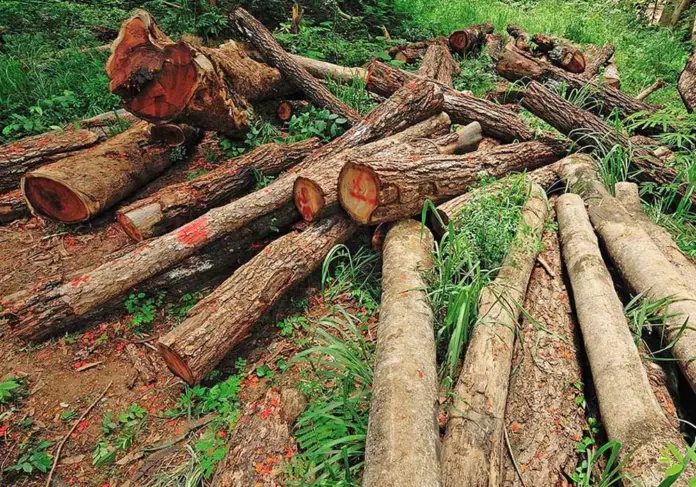The world community is observing International Day of Forests (IDF) today [March 21], with the theme “forests and sustainable production and consumption”, vowing to put efforts to protect and preserve the forests.
The day is celebrated every year after the UN General Assembly on November 28, 2012 declared March 21 as International Day of Forests, to raise public awareness about the values, significance, and contributions of the forests to balance the life cycle on the earth.
Amid the growing threats of global warming owing to Climate Change, the concept of preserving and increasing forest cover has gained more importance around the globe. Forests are considered as crucial to global sustainable development but the situation in Pakistan is not ideal as massive deforestation during the last two decades has been observed.
A World Wildlife Fund (WWF) report in 2020 depicted a very horrible situation, saying Pakistan is the second-highest in Asia after Afghanistan where over 27,000 hectares of forests are removed every year. It also stated that the country has less than 5.7 percent of forest-covered area which is far below the recommended cover of 25 percent.
However, the statistics about the forest cover of Pakistan are disputed as the Food and Agricultural Organization (FAO) marks it even lower than 2.2 percent of the total land. There are other reports indicating this area is even less than two percent.
According to Global Forest Watch, from 2001 to 2020, Pakistan lost 9.68 thousand hectares (kha) of tree cover, equivalent to a 0.99 percent decrease in total tree cover of the country. The GFW report further reads that during that period the Punjab province lost 434 ha of tree cover which is equivalent to a 1.2 percent decrease in tree cover and 125kt of CO2 emissions. In Punjab, the top two regions were responsible for 77 percent of all tree cover loss between 2004 and 2007 where Lahore had the most tree cover loss at 53ha compared to an average of 15ha.
Experts believe that if the situation continues it will enhance more landslides, more flash floods, drying up of water springs, erosion of fertile soil, sedimentation of reservoirs and desertification in Pakistan.
A suitable forest cover is not just necessary for a balanced ecosystem of any country but it also affects the geological conditions of any region. Many times, it has been observed that deforestation became one of the causes of land instability in different parts of the country, particularly in northern parts where a landslide is mostly attributed to deforestation.
World Wildlife Fund-Pakistan (WWF-Pakistan) Director Climate Change Dr. Masood Arshad believes that forest management remained an issue and became a reason for deforestation in the country.
In an interview with Minute Mirror, he said that most of the forests here were owned by local communities and managed by the forest departments, for sustainable protection the most suitable model would be the Joint Forest Management System.
“Management of Forest Resources under the REDD+ (emissions from deforestation and forest degradation) the most prominent model being that of a multi-tier payment for environmental services (PES) scheme of “passing on” carbon mitigation responsibilities and credits across scales.
As we know, Arshad said that Pakistan was a forest-poor country and the actual requirement must be more than 10 billion trees. However, he said that for this purpose, there was a requirement of financial and human resources.
“WWF has observed that KP government through its target of one billion trees increased forest cover at about 0.35 million hectares area and therefore it is fair to assume 10 billion will result in 3.5 million ha forest being added to the local inventory,” he responded to a query regarding the viability of projects like 10 billion trees.
Masood on the behalf of WWF-Pakistan agreed that forests play a crucial role in mitigating the urban heat island effect as both a sink and a source of carbon emissions. “Forests are second only to oceans as the largest global stores of carbon. Similarly, deforestation is the largest source of carbon emissions after the burning of fossil fuels,” he maintained. He continued that in one year, an acre of mature trees absorbed the amount of CO2 produced by driving a car 26,000 miles.
Moreover, Masood stressed on citizens to play their role in reducing carbon footprints through bringing change in our behaviours and traditional infrastructure along with tree plantations.
Chairman of the Department of Geography in Punjab University Dr. Safdar Shirazi believes that deforestation is one of the major causes of global climate change because of carbon sequestration.
Talking to Minute Mirror, he said that despite the PTI government’s efforts in restoration/afforestation across the country through its “Billion Tree Tsunami”, the forest management is not in an ideal state mainly because of daily consumption of wood for several purposes.
Talking about the sustainability of forests, Shirazi stressed the need to restore/rehabilitate the forests which have been on the verge of vanishing. However, he hoped that the 10 billion trees project would certainly enhance the forest cover.
“It can be hoped that by using better ground management as well through space the forest management will be better in future,” Shirazi added.
People in many areas in Pakistan have experienced the vulnerability of heatwaves, which is according to experts a result of deforestation.
However, Dr. Shirazi maintained that heatwaves and high temperatures were not being generally caused due to low vegetative cover.
“There are a number of other contributing factors like sealed surfaces, the geometry of buildings, wind movement and direction. Both these (low vegetative cove & climate change) can add their contribution to enhance heat waves but not the primary cause,” he said, adding that a severe heatwave is declared when there is a departure of 6.5 degrees Celsius or above from normal temperatures while high humidity is also a factor which can add to its severity.
“A general principle is more trees, more CO2 absorption by trees therefore if the process of deforestation continues as in many parts of the world then we are likely to have visible impacts on geographical conditions,” Shirazi said and added that if the situation continued then we could face the loss of unique habitat for endangered animal/plants species, loss of potential medicinal plants.
Among the United Nations’ Sustainable Development Goals (SDGs), the SDG-15 stresses the importance of forestry as these are crucial to global sustainable development, affecting both the natural environment and economic prosperity.
According to the United Nations, poor management, illegal logging, overgrazing and natural resources exploitation were the reasons for the highest deforestation in Pakistan. In its report, the UN body says that Pakistan is losing 1.5 percent of its forested area and the situation is posing impacts on the country’s biodiversity and environment. Amid the prevailing climate change scenario, Pakistan needs to conserve its indigenous forests.
Punjab Environment Minister Muhammad Rizwan said that the government was taking all possible steps to protect the forests in the province, knowing the fact that this was the dire need of the time.
Talking to Minute Mirror, he said that the mission of clean and green Pakistan could not be fulfilled without increasing forest cover of the country and that’s why the department was committed to assist all the departments in making efforts to bring green revolution.
“No doubt, massive deforestation during last decades have adversely impacted the geo-climatic condition of the country while it is among the major causes of environmental degradation of the country,” he said and added that the Punjab Green Development Program was aimed to control environmental degradation through increasing forest cover in the province.







